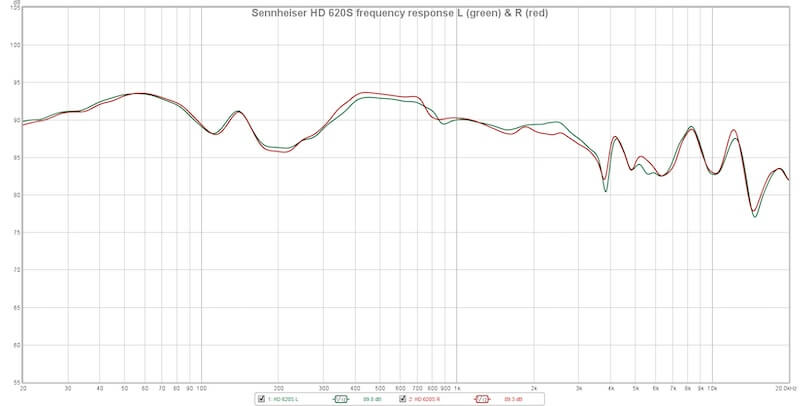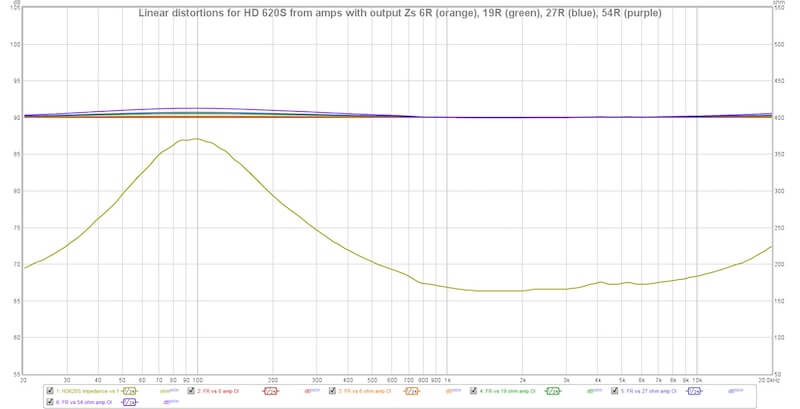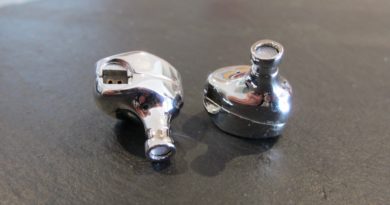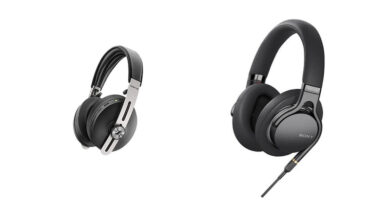Sennheiser HD 620S Review (2) – Minority Report
For closed-back headphones the Sennheiser HD620S have great staging/imaging, good timbre, and very good (for passive) sound insulation, but at the expense of an odd tonal balance and lightweight note definition. Whether or not they’re for you will come down to which sonic characteristics you hold most important.
PROS
- Isolation/leakage
- Comfort (will vary with head size)
- Sub-bass amplitude
- Stage width & imaging
CONS
- Asymmetric w-shaped FR (dips in upper bass, lower treble)
- Bass is fit-sensitive
- Light note weight & thin tone density
- Tight on big heads
- Pads could become sweaty
In this Article
The HD 620S was loaned to audioreveews.org by Sennheiser for the purposes of review and I thank them for that.
Introduction
Jürgen has already outlined the physical characteristics and specifications of these headphones in his earlier review. Here I’ll deal mostly with the purely sonic characteristics but will briefly discuss fit & comfort aspects, especially where they influence the sonics.
I listened to these mostly from a PC, using PlayPcmWin via USB to a Soekris dac1321 DAC and PassDIY WHAMMY headphone amplifier; but briefly also from Schiit Vali 2 & Massdrop Cavalli Tube Hybrid amps, and directly from a phone (Samsung Galaxy S10).
Fit & Comfort and Other Physical Aspects
The HD 5xx-style chassis is not too tight on my smaller head, but with its higher clamping force than the HD 600/650/6XX (~25% higher, according to some reviews), it might require some stretching to avoid discomfort on bigger heads. The pleather-over-foam headband pad with its large central slot is a bit uncomfortable for me, even though I don’t have the ‘Klingon ridge’ the slot is designed to account for.
The 2.5mm cable plug and its jack on the L side cup has 4 independent connectors, so the amp end of the cable could be re-terminated with a balanced plug of your choice (or replaced with a horribly expensive 4.4 mm-terminated one available separately from Sennheiser); but these headphones being relatively easy to drive (much easier than the others of the 600 series – there’s enough volume out of a phone), this isn’t necessary unless you really prefer the balanced output of your amp.
The fit, though, is fiddly. Quickly throwing them on without taking time to position them gave me different bass responses with different tries. It’s been suggested that this is due to the wrinkles/creases in the pads, which should be smoothed or squished out before listening; but measurement trials seem to indicate there might be systematic differences on different measurement ‘heads’, and therefore possibly on people with heads and ears of different sizes, shapes and hair coverage. More on this later.
Tonality
For me (once a solid fit is obtained) the most notable sonic aspect of these is an asymmetric, L-to-R amplitude-decreasing W-shaped frequency response: a strong to overdone sub-bass transitions to a dip in the upper bass & lowest mids, then back up in lower mids – disconcerting bordering on unpleasant with some bass-heavy material. I found it preferable to tweak these on my head to reduce the low bass level, or to wear glasses, thereby bringing the low rumble down to levels commensurate with the punch/pluck & reverbs higher in the bass.
The upper midrange is not overdone, which many would like, but overall the response through the mids makes female vocals and piano sound odd, there being too much emphasis on low to middle mids and not enough on upper-mid harmonics.
Higher up, the response dips further into the lower treble and rises in the mid to upper treble, the highs coming across as ‘disconnected’ as a result. While nowhere near as extreme or broad as in the IE500 Pro, which rendered cymbal shimmer very prominently but the initial hits very much less so, this sort of down-then-up treble signature seems common to a few recent Sennheiser offerings, and here was probably a deliberate choice in order to increase the perceived soundstage width of these closed-back headphones.
Timbre
Perceptions from tonal balance aside, the character of different parts of the range is generally good, with mids and treble being clean and smooth. Perceived coherence of the timbre across the range, though, suffers because of the tonal peaks and dips. Leading edges of notes are generally fast but not hard, with note weight and tone density coming across as light (although not too disagreeably so, enhancing the clean texture through the mids).
Decays also seem fast for a dynamic headphone. Notably, these don’t suffer from the excessive ‘honkiness’ or ‘boxiness’ – resonance in the middle midrange – that plagues many cheap closed-back headphone models. This aspect may be one of the HD 620S’s greatest strengths.
Technicalities
Macrodynamic amplitude is not particularly hard/high, but because of the fairly fast transients the macrodynamics don’t come across as too weak. Microdynamics particularly in the upper mids and treble seem good, possibly at least partly as a result of the treble-emphasis of the tonal balance.
Staging and imaging are highlights of these headphones. Closed-back headphones typically ‘feel’ enclosed, not giving a great sense of the space of a performance or recording venue, but with the HD 620S, the perceived width of the soundstage and the positions of instruments across are notable improvements on the narrow and ‘3-blob’ character of their open-backed HD 600-series counterparts (though the latter are certainly not regarded as staging heroes).
Despite the perception of increased width, instrument separation didn’t seem to me to be either too sharply delineated, leaving ‘holes’ across the stage, or too fuzzy, blurring everything together. If I was being critical, I might wish for a bit more separation/edge definition rather than less.
Detail/resolution and clarity, particularly from the upper mids and higher in the range, are very good; although some of this perception is likely due to the treble tilt in the frequency response, and I don’t know how much the HD 620S would scale in this respect with higher-quality amplification – something that’s often mentioned as an ability of the HD600 & HD650.
Measurements
There are numerous measurements of the HD 620S out in the wild now, including a number from pro HATS setups: e.g., Sennheiser’s own, RTINGS, the ones from The Headphone Show referenced earlier, and – one of the earliest – Solderdude’s, from his somewhat different flat-plate system. The recurring theme seems to be differences, particularly in the bass. I’m going to add my own to the mix – from my own very DIY flat-plate rig – which are different again but which illustrate to me some of the things I’ve been hearing from these, as outlined above.
On my coupler/mic setup, bass below ~70 Hz rolls off a bit more than it should (seems to vary between headphones), but that aside and ignoring narrow peaks and troughs, an approximately ‘flat in-room equivalent’ response would slope down about 1 dB/octave from ~200 Hz to ~13 kHz. Beyond ~10 kHz, I trust the measurements less and less.

Immediately evident on the above graph is a strong low bass, a trough centred on ~200 Hz, and a hump in the lower to middle mid-range, 400~700 Hz. This corresponds to the left-hand half of the asymmetric w-shaped tonal balance I described earlier. The peak at 140 Hz and a portion of the trough to the left of it are I think what Tyll Herstens of the late great headphone site Innerfidelity called ‘pad bounce’, a resonance artifact due to pad springiness and the air volume of the ear chamber that has shown up to varying degrees in my measurements of other closed-back headphones and of some IEMs.
As well as the pad-dependent differences in fit on different measurement couplers mentioned earlier, different expressions of ‘pad bounce’ might also be contributing to the very different bass measurements shown by different measurement systems. Solderdude’s flat-plate measurement has bumps that correspond with mine in frequency but are much lower in magnitude; and The Headphone Show’s measurements on their B & K and GRAS rigs have a hump centred on 100 Hz that’s not present in Sennheiser’s measurement on a different GRAS system.
Moving to higher frequencies, we see, narrow peaks & dips aside, the other half of the ‘w’: a relatively low-amplitude interval from ~4 kHz to ~7 kHz next to a relatively high-amplitude interval between ~ 8 kHz and ~12 kHz (remember, ‘flat’ in these measurements would be an overall gentle downward slope from left to right). This corresponds to the relatively depressed lower treble and elevated mid (and upper) treble I hear.
The impedance vs frequency profile of the HD 620S is typical Sennheiser, with a peak around 100 Hz reflecting the primary resonance of the driver/enclosure system. In contrast to the HD 600 and HD 650/6XX, however, HD 620S impedance is lower throughout, being slightly above 150 Ohms over much of the range and under 350 Ohms at the peak. This range makes the HD 620S comfortable to drive from a wide range of headphone amplifiers, and even from tube amps with high output impedance, the phones’ impedance profile will hardly amplify the bass response.

Comparisons
This is a bit tricky, as the HD 620S falls at a price in-between many other closed-back dynamic offerings like the Beyerdynamic DT 700/770 and Sennheiser’s own HD 569 at half the price or a bit more, and others like the Beyerdynamic DT 1770 Pro or Shure SRH-1540, which depending on sales are approx. $US 150-250 more. On the cheaper side, closed-back headphones I used to own include the Sennheiser HD 598Cs and HD 280 Pro, both a tier below the HD 620S in price and performance. Jurgen briefly compared a few cheaper closed-backs in his review, and Solderdude gives comparative measurements and brief descriptions in his.
I currently have a pair of the Massdrop/Fostex TH-X00 (Mahogany), which were $US 400 when originally available. These are relatively ‘open’ sounding for closed backs, possibly because they don’t seal very well, having low isolation and high leakage. Tonally, they’re U-shaped, with big, round bass and peaky, somewhat rough mid-treble; but in between, relatively even, with smooth, detailed mids.
A single ply of thin toilet paper in front of the driver took down the worst of the treble peaks (while sacrificing a bit more resolution there) and – for me – turns these into a headphone with a tonal balance that I prefer over the HD 620S, (overly) bassy but without distracting peaks and dips, and with a smooth and detailed delivery through the mids. But, the insulation of the HD 620S – the reason to have closed-backs in the first place – is vastly superior.
Given the contention that the HD 620S is a ‘closed HD 600 with added bass’, another comparison worth making is with the open headphones of the HD 600 series. Compared to my HD 6XX, now fitted with the Custom Cans mod and a pair of ZMF perforated suede pads, I find the w-shaped tonal balance of the HD 620S disappointing, the uneven and unpredictable bass response disconcerting, and the improved staging and imaging of the latter to be outweighed by the better resolution and timbre of the former. So if the insulation of a closed-back is not a must-have, I’d have no hesitation in choosing the HD 600 or 650/6XX over the HD 620S.
Conclusions
I really wanted to like the HD 620S. Added bass aside, the prospect of an HD 600-series headphone in a well-insulating package was very appealing. For me, however, the HD 620S’s w-shaped tonal balance is a downside that’s not outweighed by their superior staging/imaging and contrasting technicalities (‘speed’ vs ‘weight’), and ultimately I’m not prepared to sacrifice my sonic preferences for great isolation and leakage performance. Your preferences and priorities might be different from mine, but nonetheless I’d recommend spending as much time as you can trying these out before you buy.
Note from the editor: both co-bloggers, Alberto and Kazi, purchased a pair of the HD 620S.





